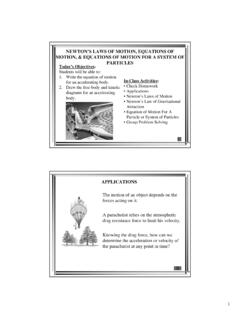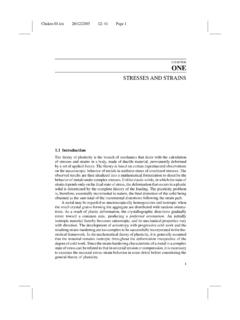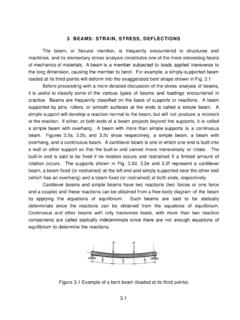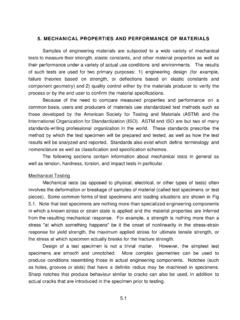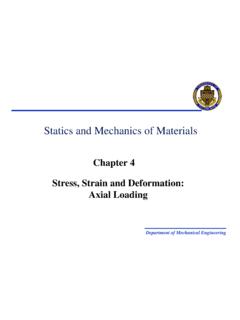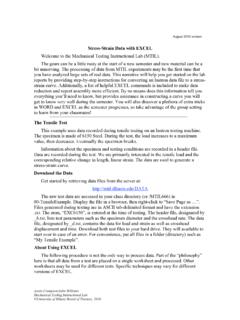Transcription of PLASTIC DEFORMATION BACKGROUND
1 PLASTIC DEFORMATION AND stress - strain CURVES BACKGROUND Unit: PLASTIC DEFORMATION and stress - strain Curves Introduction In the last unit we studied the elastic response of materials to externally applied loads. All the loads applied were well below the elastic limit of the materials so no permanent DEFORMATION occurred in the sample. In this unit we will continue our study of the effects of externally applied forces and will apply loads large enough to cause permanent DEFORMATION and eventually fracture . Objectives After studying this unit and completing the lab assignment you should be able to perform the following tasks: 1. Write definitions for the following terms, including SI and English units when appropriate.
2 A. Pascal b. offset yield strength c. ultimate tensile strength d. PLASTIC strain e. hardness 2. Given specific dimensions and load-elongation data from a metal tensile test, calculate stresses and strains, plot an appropriate stress - strain curve, and determine the yield strength (by the offset method when appropriate or by the sudden change in slope of the stress - strain curve when appropriate), the elastic modulus, and the ultimate tensile strength. 3. Given the dimensions of a tensile test specimen before and after testing calculate the percent elongation and the percent reduction in area. 4. With the assistance of a classmate, run a tensile test on a metal sample obtaining load and elongation data.
3 PLASTIC DEFORMATION After a material has reached its elastic limit, or yielded, further straining will result in permanent DEFORMATION . After yielding not all of the strain will be recovered when the load is removed. PLASTIC DEFORMATION is defined as permanent, non-recoverable DEFORMATION . PLASTIC DEFORMATION is not linear with applied stress . Recall if a material experiences only elastic DEFORMATION , when the stress is removed the elastic strain will be recovered. If a material is loaded beyond its yield point it experiences both elastic and PLASTIC strain . After yielding the rate of straining is no longer linear as the applied stress increases. When the stress is removed, only the elastic strain is recovered; the PLASTIC strain is permanent.
4 Elastic DEFORMATION occurs as the interatomic bonds stretch, but the atoms retain their original nearest neighbors and they "spring back" to their original positions when the load is removed. Clearly in order to have permanent DEFORMATION there must be permanent movement in the interatomic structure of the material. Although some of the atoms move away from their original nearest neighbors not all of the interatomic bonds are broken (this is evident because we can achieve permanent DEFORMATION without fracture of the material). The mechanism for permanent DEFORMATION is called slip. Slip occurs when planes of densely packed atoms slide over one another: individual bonds are broken and reformed with new atoms in a step-wise fashion until the desired DEFORMATION is achieved.
5 stress - strain Curves Again we will use stress - strain curves to investigate the mechanical behavior of materials. Recall most of the properties aren't dependent on the specimen size, and the elastic modulus is the same whether we use a tensile test or a compression test to find it. Since the strain will be positive for tensile testing. A tensile stress will also be positive and And during the initial DEFORMATION of the material when the strain is elastic, the stress and strain are related linearly by the elastic modulus. stress - strain curves for metals come in several basic types (Fig. 1). The linear portion of the stress - strain curve indicates elastic, or recoverable, DEFORMATION .
6 The non-linear portion indicates PLASTIC DEFORMATION . PLASTIC strain is defined as permanent, non-recoverable DEFORMATION . Curve A is for a metal which broke while still showing linearly elastic behavior. Curve B is the most common type of stress - strain curve, a gradual deviation from linear behavior as PLASTIC flow (yielding) begins. Curve C shows the behavior of some steels, a sudden deviation from elastic behavior at the yield point, a sharp, easily identified yield point. (The solid lines on the stress - strain curves indicate real data, the dashed lines indicate a best guess or interpolation between known data points.) strain = = stress = = stress , psi y A B C strain , in/in Figure 1 Recall that the elastic modulus is defined by the relation: = E so by rearranging this equation we can write: This equation is valid only for the elastic portion of the curve, that is, the linear region of the stress - strain curve.
7 We can easily calculate the elastic modulus of a material by calculating the slope of the straight-line portion of the stress - strain curve. Regardless of how much total strain a specimen experiences the elastic strain is always recovered when the load is removed. total strain = elastic strain + PLASTIC strain total = elastic + PLASTIC The recovery (or "unload") curve that is produced when the load is removed from a specimen is parallel to E. The amount of strain recovered during the unloading process is the elastic strain ; the amount of strain that remains in the specimen after unloading is the PLASTIC strain (Fig. 2) The yield strength, or yield point, is defined as the stress at onset of PLASTIC DEFORMATION .
8 The material used to generate curve A in Fig. 1 did not exhibit PLASTIC DEFORMATION before rupture. Curve C in Fig. 1 shows an easily identifiable, sharp yield point. Materials showing behavior like that in curve B of Fig. 1 have a gradual onset of yielding though, so the yield point is arbitrarily defined as the stress at which an offset line, paralleling the linear part of the stress - strain curve, but starting from a strain offset of (or ), intersects the stress strain curve. The offset yield strength is the stress associated with a small, allowable amount of permanent DEFORMATION ; the offset yield strength is the stress associated with PLASTIC strain . An important measurement that must be made when evaluating load- elongation data is the specimen gage length.
9 The gage length is the length of the specimen over which the elongation is measured. With large amounts of DEFORMATION the strain will change if the gage length is changed. E = stress , psi Load unload E E PLASTIC elastic total strain Figure 2 Another important property determined from the stress - strain curve is the maximum stress reached. This is often called the ultimate tensile strength ( UTS or UTS) or sometimes just tensile strength. The UTS is calculated: where: Fmax = maximum applied load Ao = original cross-sectional area The breaking strength is defined as the load at rupture (breaking) divided by the original cross-sectional area. where: Fbreak = load at rupture A stress - strain curve with the yield strength, ultimate tensile strength and breaking strength indicated is shown in Fig.
10 3. True stress The breaking strength is often less than the ultimate tensile strength and may even be less than the yield strength. That is sometimes troubling because it does not seem possible that it would require less energy to finally rupture the specimen than it does to cause the initial yielding. In fact the stress required to actually break the specimen is greater than any other stress the specimen experiences. Recall the stress - strain curves that we are constructing are based on the original specimen dimensions, but the specimen is actually changing dimensions as the test proceeds. After yielding, permanent DEFORMATION occurs and the specimen's cross-sectional area is decreasing. With further loading the DEFORMATION becomes exaggerated in a localized area and a "neck" forms in the specimen.





